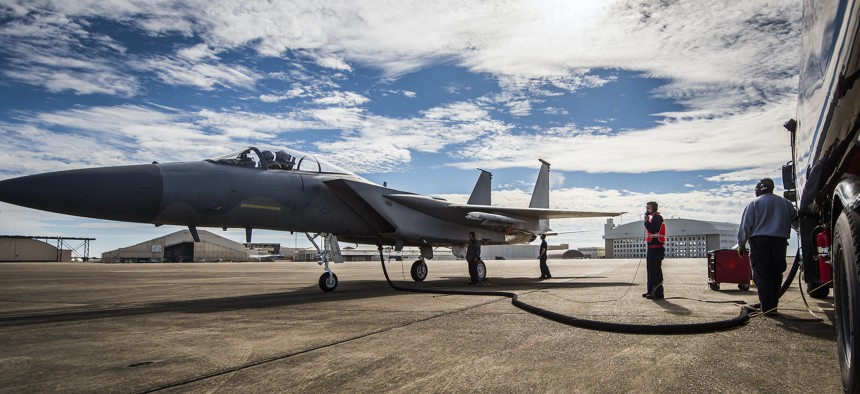Aviator Cancer Bill Would Push VA to Study Toxins Air Crews Faced, Assess Links to Cancers
Ground crew and flight crew cancers would be reviewed. So would the fuels, chemicals, and emissions they were exposed to.
Just like the fighter pilots they supported, many troops who fueled, armed, and maintained warplanes have suffered from cancer or seen their former colleagues diagnosed with the disease. There’s no data yet on how many ground crew members have gotten sick, but a new bill introduced Thursday would require the Department of Veterans Affairs to identify the cancer incidence in the entire aviation community, as well as what toxins they faced, and whether there could be a link to their illnesses.
The ‘‘Aviator Cancer Examination Study Act’’ would require the VA to not only determine the cancer incidence rates for air and ground crews, but also identify the “chemicals, compounds, agents, or other phenomena” they were exposed to. Additionally, it would require the VA to conduct a concurrent study to determine whether there is “a scientifically established causal link between such a chemical, compound, agent, or other phenomena and such cancer incidence or mortality risk.”
The bill differs from another major piece of legislation passed in the 2021 defense authorization act that also includes ground crews, in that toxin identification is required regardless of whether an overall elevated cancer incidence is found. It’s a difference that bill sponsor Rep. August Pfluger, R-Texas, hopes could help sick aviators get their care covered more quickly by the VA.
Pfluger is a colonel in the Air Force Reserves, and an F-15 and F-22 fighter pilot with almost 2,000 flight hours.
“I've served with many pilots that had cancer,” Pfluger told Defense One in a phone interview Thursday. “Some of them didn't survive.”
The bill was co-sponsored by Rep. Colin Allred, D-Texas; former F/A-18E Super Hornet Navy pilot Rep. Mike Garcia, R-Calif., and many others, to assist pilots and maintainers now sick with cancer.
Helping those aviators is part of a larger push by veterans groups and comedian Jon Stewart to finally address the many ways service members have gotten sick with cancers and other illnesses after war and deployments due to the toxins they were exposed to.
A major new bill to give the troops who were exposed to burn pits an easier path to VA care was passed by both the House and Senate earlier this year; President Joe Biden signed another burn pit-related bill into law in 2021.
However, aviation-specific cancers are still being addressed by Congress, and aircrews are facing the same uphill battle more than 260,000 burn pit registry troops faced: Getting the government to recognize potential links between their exposures and illnesses.
But recent studies have suggested that pilots and aircrew are experiencing higher rates of cancer than their non-flying peers.
An Air Force study released last year found that when compared to non-aviation service members, fighter pilots and their flight crews were 29 percent more likely to be diagnosed with testicular cancer; 24 percent more likely to be diagnosed with melanoma; and 23 percent more likely to be diagnosed with prostate cancer.
Clusters of cancers have already been identified. At Seymour Johnson Air Force Base between 2002 and 2005, six F-15E Strike Eagle pilots and weapons officers between the ages of 33 and 43 were diagnosed with urological cancers; and a separate study found a cluster of seven brain cancers among Air Force Special Operations Command C-130 aircrews between 2006 and 2009. The crew members diagnosed were all between the ages of 31 to 46.
The Pentagon is expected to report soon the results of a data review required by Congress in Section 750 of the 2021 National Defense Authorization Act of cancers among aviators and ground crew across all services. But that study will only require a much more in-depth follow-up–and to identify potentially-linked toxins “if … the [Secretary of Defense] concludes that there is an increased rate of cancers among covered individuals.”
If Defense Secretary Lloyd Austin does determine a follow-up is needed, then the next study would break down the cancers by aircraft and by occupation of each service member, by locations deployed, and would identify any “operating environments, including frequencies or electromagnetic fields, where exposure to ionizing radiation (associated with high altitude flight) and nonionizing radiation (associated with airborne, ground, and shipboard radars) occurred in which covered individuals could have received increased radiation amounts.”
Former pilots have questioned whether they were shielded well enough from high-powered radar emissions and the power sources inside fighter jet nose cones. Pilots and crews spend hundreds of hours sitting above that gear as they fly missions, and ground crews are also exposed as they work on the jets.
Pfluger’s bill would require the VA to identify potential toxins now. It would also require the VA to use non-DOD death registries that may capture cancer deaths among individuals who reported military service but did not complete a 20-year career, such as many of the young enlisted troops who service jets for a few years and then get out. Those individuals would not have qualified for lifetime DOD health care and are less likely to have ever used the VA health care system.
“It comes down to expanding the sample size enough so that you can see whether or not there's scientific correlation,” Pfluger said.








